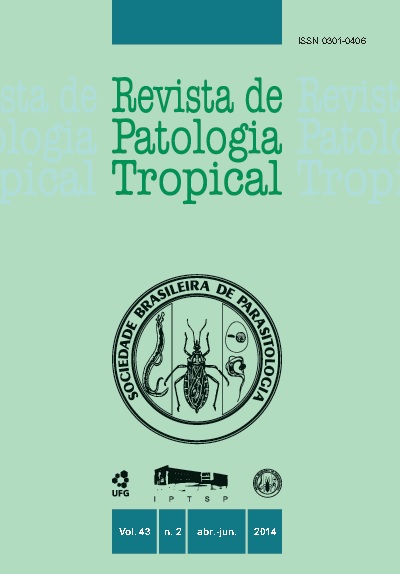ANALYSIS OF THE EPIDEMIOLOGICAL PROFILE OF HANTAVIRUS IN BRAZIL FOR THE PERIOD 2007 TO 2012
DOI:
https://doi.org/10.5216/rpt.v43i2.31115Keywords:
Epidemiology, zoonoses, hantavirus.Abstract
Hantaviruses are zoonoses that cause serious human diseases in the Americas such as hantavirus pulmonary syndrome (HPS). In Brazil HPS is a notifiable disease to health services due to its high lethality and incipient knowledge of its epidemiology. The present study describes the epidemiology of HPS in Brazil for the period 2007-2012. We conducted a descriptive study of the records of the National Notifiable Diseases System, analyzed the reporting forms and research, and the data wereevaluated for completeness of information, opportunity and profile of registered cases. The results are presented as raw numbers, measures of central tendency and proportion and analyses developed using Excel 2010 software, and 32 Tabwin terraView. In the study period 8,456 cases of HPS were reported, with confirmation of 9% (756/8,456), ideally by laboratory testing 91.1% (689/756). The average coefficient of lethality for the period was 38.2%, whilst the highest incidences of the disease were in the states of Mato Grosso, Santa Catarina and the Federal District and the greatest lethalities were in Amazonas, Mato Grosso and São Paulo. Regarding seasonality, cases were observed in all months of the year. Deaths were more frequent in males 72.3% (209/289) and high mortality was observed in women 42.3% (80/189). The cases were mainly people who conducted activities related
to agriculture 18.8% (90/478) who were exposed to the rodent environment, 36.9% (279/756). Most of the patients 90.3% (683/756) required hospitalization and the average time expressed in number of days between the variable onset of symptoms and hospitalization, cure or death variables, were respectively (5, 11, 18). The data presented in this study highlight the necessity to focus technical skills on the recognition of the circulation of the agent, the opportunity for diagnosis and treatment and quality of information and priority factors for the strengthening of epidemiological surveillance programs of hantavirus.
Downloads
Downloads
Published
How to Cite
Issue
Section
License
The manuscript submission must be accompanied by a letter signed by all authors stating the full name and email address, confirming that the material has not been published or is under consideration for publication elsewhere, and agreeing to transfer copyright in all media and formats for Journal of Tropical Pathology. The authors will not be paid for published articles. They are solely responsible for the content of those articles, even if the Editor holds the right to adjust them to the norms of the journal.
The reviewers will not be paid for the peer review process.

